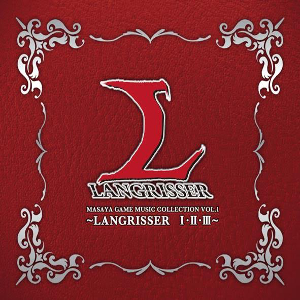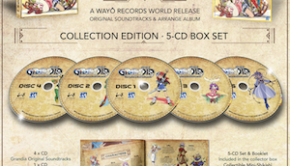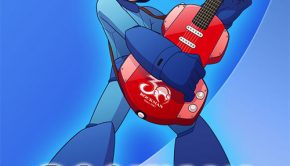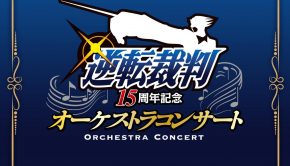Langrisser I-II-III / Masaya Game Music Collection Vol. 1
 |
Album Title: Masaya Game Music Collection Vol. 1 -Langrisser I, II, III- |
| Record Label: Sweep Record |
|
| Catalog No.: SRIN-1129 |
|
| Release Date: December 15, 2015 |
|
| Purchase: Buy at CDJapan |
Overview
The Masaya Game Music Collection Vol. 1 -Langrisser I, II, III- contains the music for the first three games in the Langrisser series across their various incarnations. These tactical RPGs won a strong cult following throughout the 90s and were particularly acclaimed for their refreshing rock-themed soundtrack. This box contains the music for the PC-Engine and Mega Drive versions of Langrisser, the Mega Drive, Super Nintendo, and PlayStation versions of Langrisser II, and the Sega Saturn’s Langrisser III. The music was predominantly written by Noriyuki Iwadare (Langrisser, Langrisser II) and Hiroshi Fujioka (Langrisser, Langrisser III), with guest contributions from various other members of the CUBE unit along the way. While most of these soundtracks have been previously released, they are only available through obscure out-of-print series or Japan-only digital record stores. Hence SuperSweep’s six disc box set here provides a comprehensive, definitive collection of the early music in the series. How is the overall listening experience?
Body
The first disc is dedicated to the music of the first game in the series and features the original Mega Drive version of the soundtrack (known as Warsong in the West) followed by the PC-Engine version (released as Langrisser: Descendants of Brilliant Light). The “Theme of Langrisser” is a great FM tune with an excellent melody and militaristic tone. One of the few synth orchestral tracks written for the game, the instrumentation sounds surprisingly robust for the console and Iwadare’s arrangement is quite impressive with its classical lilt. Elements of this theme were arranged in subsequent additions to the series. The PC-Engine version carries the same tone, but features much richer orchestral samples thanks to the CD audio capacity of the platform. The arrangement provides some excellent contrasts mellow woodwinds and militaristic brass.
The various “Your Army” themes all have a rock sound more typical of the tone of the series. All of them boast rich memorable melodies that motivate players for battle. Whereas the Mega Drive versions are excellent examples of FM synth rock tracks, the PC-Engine versions take on a synth rock approach with some orchestral tones in some of them. The “Enemy Army” themes are more varied in approach. “Enemy Army BGM 1” is a mysterious piece highlighting some excellent quasi-improvised keyboard sections in its FM version and some strings and woodwinds in the PC-Engine version. “Enemy Army BGM 2” is a bass-heavy rock tune, with the PC-Engine version featuring sharp synth and rock tones as well as a great guitar solo. “Enemy Army BGM 3” sounds tense and mysterious tune in the original while the PC-Engine version features some great bass, ethereal synth, and adds a rock element as well.
In addition to these tunes, the PC-Engine soundtrack features some music not heard in the original Mega Drive version. “Your Army BGM 4” is an energetic woodwind-fuelled rock theme boasting a solid melody and great solos while “Your Army BGM 5” is a high energy synthy theme. Another solid addition is “Enemy Army BGM4”, which brings some variety to the gameplay with its contrast of upbeat and ominous sections. The game also featured a vocal theme composed by Hiroshi Fujioka and performed by Mayumi Sudo, “Don’t stop your dream”. It’s an upbeat pop rock tune boasting a great melody with a solid performance as well. A surprisingly well-produced song for 1993 and yet more evidence that CUBE Co. were ahead of their time.
The next four discs feature the music of Langrisser II in its original Mega Drive rendition, as well as its Super Nintendo (Der Langrisser) and PlayStation (from Langrisser I & II) renditions, each with their own sounds. Note that, while the PlayStation version was a remake of both Langrisser titles, its soundtrack is primarily an arrangement of Langrisser II‘s. “Ally 1 [Neo-Holy War]” is an utterly catchy piece blending a bright rock melody with heavy drum rolls. Any Langrisser player will know this song, which has become a mainstay of the series in its various renditions. While the original rendition is impressive, the Super Nintendo version and PlayStation versions are notably with their respective orchestral tones and synth rock tones. “Ally 2 [Knights Errant]” and “Ally 6 [Soldier]”, also fan favorites, are written in a similar way and both enthrall throughout their extensive development. “Ally 3 [No Surrender]” also features an excellent melody with its upbeat tempo and synth usage whereas both the Super Nintendo and PlayStation versions are more orchestral in tones. “Ally Reinforcements [One’s Side]” is another notable piece that significantly differs in its arrangements between the versions.
Of course, there are also a lot of enemy themes featured across the four discs dedicated to Langrisser II. The contrast between the ally and enemy themes is much more pronounced than in the original, with the enemy themes having darker undertones despite having their motivating motivating. “Enemy 1 Leon” and “Enemy 3 Morgan” continue the rock emphasis of the rest of the soundtrack, but each have a moodier tone and edgy rhythm parts. “Enemy 2 Vargas” is an ominous tune featuring some great bass and some orchestral rock influence while also featuring a great B section. The Super Nintendo and PlayStation versions are both orchestral in nature, with the former having some synth rock tones. Less impressive is “Enemy Reinforcements [Reinforce of Enemy]” that, while technically competent, doesn’t quite have the same melodic charisma as the other tracks here. A surprising contrast is provided by “Enemy 6 Imelda”, which is seemingly inspired by Streets of Rage‘s dance tone and has a more upbeat arcade-like sound. Another example of CUBE Co.’s stunning Mega Drive synthesis, “Enemy 7 Dark Princess” has a tonne of edge with its heavy synth melody and thrashing guitars. The Super Nintendo version is notable for featuring a violin lead with the same rock tones but also features some woodwinds as well, while the PlayStation version features upgraded synth although ditches the violin.
Remember I said that “Theme of Langrisser” was arranged in a sense in other instalments of the series? Well, this comes with Langrisser II‘s “Ally 5 [Legend of the Sword]”, a slow-paced almost-elegaic orchestral theme. It’s a stark contrast to the rest of this large upbeat, rock-centric soundtrack and a welcome one at that, bringing some depth to the score and capturing the darker side of battle. The Der Langrisser version isn’t quite as effective due to the limitations of the SPC chip. However, the PlayStation version definitely delivers with its more fleshed-out orchestral sound brought to reality with some impressive synthetic orchestration. Mirroring this approach is “Enemy 9 Bernhardt”, a dramatic, almost funereal tune featuring orchestral sounds. The orchestration is again especially satisfying in the PlayStation version. All the tension built up is released in “Ally 7 [Last Battle]”, which returns to the rock roots of the soundtrack but brings with it a dramatic melody and tons of energy. Whereas the Super Nintendo version is orchestral with some rock synth added, the PlayStation version features a lusher orchestral tone and incorporates more synth elements.
There are several ending themes on the Langrisser II soundtrack, by far the best and longest being “Ending 2”. Capturing Iwadare at its peppiest, it’s a great synthpop tune with an upbeat and memorable melody. The PlayStation version being a more realized synth rock rendition. By comparison, the Super Nintendo version takes an orchestral rock approach and is much shorter in length. There are also several exclusive tracks to the Super Nintendo and PlayStation versions that aren’t found in the original Mega Drive version. On the ally side, there’s the upbeat orchestral rock theme “Ally Reinforcements 2” and another dramatic rock piece “Ally Reinforcements 3”. “Enemy Reinforcements 2,” by contrast, is an orchestral rock tune that is beautiful yet frenetic. The PlayStation version also features two opening themes created for the FMV sequences, though disappointingly they’re filled with sound effects. Better exclusives are the six “Addition” tunes featured on the otherwise sparse fifth disc of the soundtrack. These are mostly rock-oriented tracks written in the style of the classic soundtracks of the series, with more than a few orch hits thrown in for good measure. Similarly, “Ending 1” is only featured in the Mega Drive and Super Nintendo version and is a dramatic, contemplative orchestral tune particularly in the latter version.
The final disc contains the music of Langrisser III on the Sega Saturn. Of all the music present in this collection, the soundtrack to this game is probably the weakest, mostly due to how short many of the tunes featured on the soundtrack are. It opens with “To the Future,” a rock vocal theme written in the same spirit of “Don’t Stop Your Dream”, though is surprisingly less well-produced overall. It is still quite enjoyable thanks to the powerful melody and reasonably strong vocal performance. More reflective of the tone of the rest of the soundtrack is “Main Theme [Hero’s Theme 1]”, a synth orchestral track with an adventurous tone. There’s also a much more expansive second rendition that features more variety in its sound, as well as a moodier slow version. While tracks such as these preserve the spirit of the Langrisser series, the arrangements and production values are a considerable step backwards from those features in the PC-Engine and PlayStation remakes.
The various character themes present on the game all vary in sound, ranging from the rocking “Jessica’s Theme”, orchestrated “Ruin’s Theme”, and synthpop-flavored “Riffany’s Theme”. Though they’re decent enough while they each last, they’re all drastically short and last just 40 seconds each. I expected much more than this from a Langrisser title. The rest of the tracks follow suit. “Your Army A [NPC Theme] is upbeat in tone, but is quite repetitive in its original version, while “Your Army B [Other PC Theme] is a largely forgettable orchestral piece. Both “Artemueller’s Theme” and “Dark Knight Theme” are both short-lived synth rock tunes, while “Bharal’s Theme” features dark industrial rock and “Velzeria MC Theme” takes a more gothic tone. Thankfully, the themes for Velzeria and Shika feature two versions each, the second versions of which are more fleshed out if still not fully developed.
The second half of the soundtrack features a few fully-fledged compositions more in line with the excellence we came to expect from Langrisser II. “Enemy Attack 1” is a great orchestral rock tune with an excellent melody and is upbeat and heroic at times while “Enemy Attack 2” is a dramatic if somewhat drab orchestral affair. “Dark Knight Requiem” is a somber and pensive tune let down by a merely serviceable melody, while “Sophia Requiem” features somber woodwind tones and “Flaire Requiem” is a beautiful harp-supported piece. “Slight Advantage Music” is a heroic if stereotypical march, while “Advantage Music” is a gallant orchestration with a great melody. “Disadvantage Music” is tense and determined in sound, while the rhythmically-jagged “Balance Music,” despite its name, sounds to me more disadvantageous and dramatic than the designated track. “Final Stage Music” is another piece with a very determined orchestral sound that really ties well into the first game in the series by incorporating “Theme of Langrisser” into its composition. Other standouts include “Rescue” with its heroic orchestral sounds and catchy melody and “Ending” with its bright and celebratory orchestral sounds, stand out much more. There’s also another vocal theme, “Lovin’ You -Departure at Morning-“, a soft pop ballad with some lovely vocals.
Summary
Overall, the Masaya Game Music Collection Vol. 1 -Langrisser I, II, III- is a strong compilation of the rich early musical history of the Langrisser series. In terms of success, the first two games in the series shine compared to the third game in the series, whose short track times and stereotypical don’t do too many favors to the tracks themselves. The second game features a particularly excellent soundtrack, blending tonnes of memorable melodies, impressive stylings, and rich implementation in all its incarnations. While I won’t make a call on the definitive versions of the various soundtracks featured in the collection, there is something here for everyone, whether they prefer the FM rock stylings of the Mega Drive versions or the more updated orchestral sounds of the PC-Engine and PlayStation. In the end, fans of the series can now pick up the first three soundtracks in one complete, convenient, reasonably-priced package should they so wish.
Do you agree with the review and score? Let us know in the comments below!
4
Posted on January 25, 2016 by Don Kotowski. Last modified on January 25, 2016.














